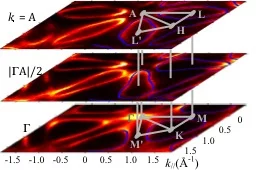The electronic band structure E(k) as energy E of the electrons depending on its wavevector k is the cornerstone concept of the quantum solid state theory. The main experimental method to investigate E(k) is the angle-resolved photoelectron spectroscopy (ARPES). However, a small photoelectron escape depth of a few Å largely restricts the applications of ARPES to two-dimensonal crystals. A team of SLS scientists working at the ADRESS beamline have recently extended this technique to the much wider world of three-dimensional (3D) crystalline systems. They used soft-X-ray synchrotron radiation in the soft-X-ray photon energy range around 1 keV, where the photoelectron escape depth and concomitantly the 3D k-vector definition increase by a factor of 3-5. The problem of a dramatic loss of the photoexcitation cross-section by a few orders of magnitude in this energy range has been overpowered with ADRESS beamline, which delivers high photon flux exceeding that of the closest competitors by up to 2 orders of magnitude. The pilot soft-X-ray ARPES research has been carried out on the paradigm transition-metal-dichalcogenide VSe2. Unparalleled definition of the 3D k-vector has allowed the scientists to explore in 3D the Fermi surface of VSe2 determining the whole host of its unusual macroscopic properties including the electric conductivity anomalies. The textbook calrity of the experimental FS (figure) manifests excellent definition of the 3D k vector and regular photoexcitation matrix elements achieved at soft-X-ray energies. Autocorrelation analysis of 3D warping of the experimental Fermi surface has revealed its nesting as the precursor for the exotic 3D charge density waves in VSe2. This pilot research has been followed in the last year by a plethora of other breakthrough experiments exploiting the advantages of soft-X-ray ARPES on the probing depth and 3D k-vector definition, such as the electronic structure of Mn ferromagnetic impurities in the paradigm spintronic material GaMnAs, buried 2D electron gas in LaAlO3/SrTiO3 hererostructures, standing X ray waves excited ARPES of multilayer heterostructures allowing depth resolved electronic structure profiling, etc.
Read the full story
Read the full story
Reference
Three-Dimensional Electron Realm in VSe2 by Soft-X-Ray Photoelectron Spectroscopy: Origin of Charge-Density WavesV.N. Strocov, M. Shi, M. Kobayashi, C. Monney, X. Wang, J. Krempasky, T. Schmitt, L. Patthey, H. Berger and P. Blaha, Physical Review Letters 109 (2012) 086401
DOI: 10.1103/PhysRevLett.109.086401
Contact
Dr. Vladimir N. Strocov, Swiss Light SourcePaul Scherrer Institute, 5232 Villigen PSI, Switzerland
Tel. +41 56 310 5311, email vladimir.strocov@psi.ch
